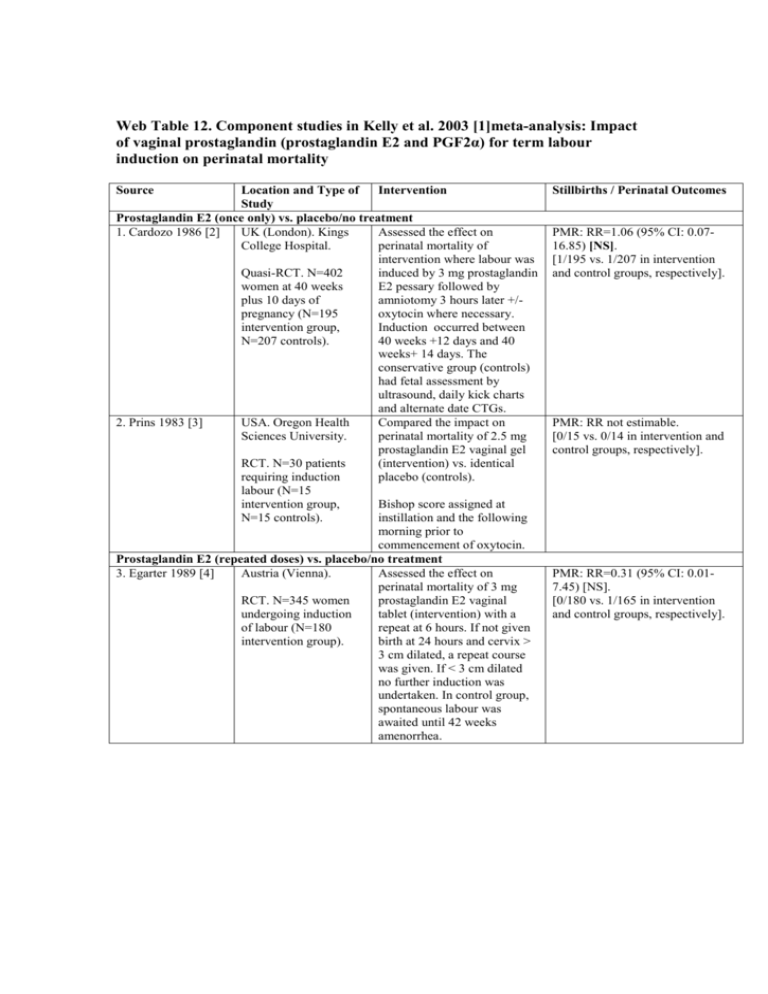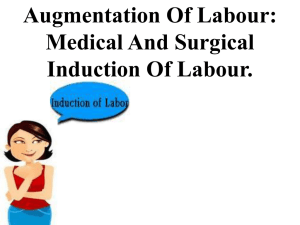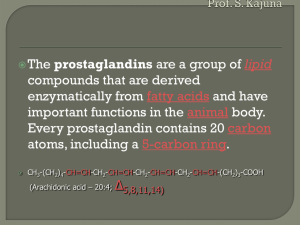file - BioMed Central
advertisement

Web Table 12. Component studies in Kelly et al. 2003 [1]meta-analysis: Impact of vaginal prostaglandin (prostaglandin E2 and PGF2α) for term labour induction on perinatal mortality Source Location and Type of Intervention Study Prostaglandin E2 (once only) vs. placebo/no treatment 1. Cardozo 1986 [2] UK (London). Kings Assessed the effect on College Hospital. perinatal mortality of intervention where labour was Quasi-RCT. N=402 induced by 3 mg prostaglandin women at 40 weeks E2 pessary followed by plus 10 days of amniotomy 3 hours later +/pregnancy (N=195 oxytocin where necessary. intervention group, Induction occurred between N=207 controls). 40 weeks +12 days and 40 weeks+ 14 days. The conservative group (controls) had fetal assessment by ultrasound, daily kick charts and alternate date CTGs. 2. Prins 1983 [3] USA. Oregon Health Compared the impact on Sciences University. perinatal mortality of 2.5 mg prostaglandin E2 vaginal gel RCT. N=30 patients (intervention) vs. identical requiring induction placebo (controls). labour (N=15 intervention group, Bishop score assigned at N=15 controls). instillation and the following morning prior to commencement of oxytocin. Prostaglandin E2 (repeated doses) vs. placebo/no treatment 3. Egarter 1989 [4] Austria (Vienna). Assessed the effect on perinatal mortality of 3 mg RCT. N=345 women prostaglandin E2 vaginal undergoing induction tablet (intervention) with a of labour (N=180 repeat at 6 hours. If not given intervention group). birth at 24 hours and cervix > 3 cm dilated, a repeat course was given. If < 3 cm dilated no further induction was undertaken. In control group, spontaneous labour was awaited until 42 weeks amenorrhea. Stillbirths / Perinatal Outcomes PMR: RR=1.06 (95% CI: 0.0716.85) [NS]. [1/195 vs. 1/207 in intervention and control groups, respectively]. PMR: RR not estimable. [0/15 vs. 0/14 in intervention and control groups, respectively]. PMR: RR=0.31 (95% CI: 0.017.45) [NS]. [0/180 vs. 1/165 in intervention and control groups, respectively]. 4. Hannah 1996; Gafni A, et al. 1997 [5, 6] Canada. 5. Liggins 1979 [7] New Zealand. University of Auckland. RCT. N=5041 women with prelabour rupture of the membranes at term. RCT. N=84 women requiring induction of labour for major or minor complications of pregnancy (N=26 intervention group # 1, N=26 intervention # 2, N=32 controls). 6. Shoaib 1994 [8] Pakistan (Lahore). Allama Iqbal Medical School. RCT. N=200 primigravid women (N=100 intervention group, N=100 controls). Compared the impact of IV oxytocin, immediate (intervention # 1) vs. vaginal prostaglandin E2 q6h x 2, then IV oxytocin if still not in labour (intervention # 2) vs. expectant management x 96 hrs, IV oxytocin if still not in labour (control # 1) vs. expectant management x 96 hrs, vaginal prostaglandin E2 as above if still not in labour (control # 2). Compared the impact of 0.2 mg (intervention # 1) vs. 0.4 mg (intervention # 2) prostaglandin E2 vaginal suppositories vs. identical placebo (control) placed at 0900; then self administered repeat suppositories at 2 hourly intervals. Rested overnight and continued until 15 suppositories used or labour ensued. If not in labour after 48 hours patients underwent induction by amniotomy and oxytocin. Compared the impact of active management with 3 mg prostaglandin E2 vaginal tablets (intervention) vs. conservative management. prostaglandin E2 tablets every 6 hours to a maximum of 3. No details given of conservative management. Prostaglandin E2 (sustained release) vs. placebo/no treatment 7. Prasad 1989 [9] Singapore. National Compared the impact on University Hospital. perinatal mortality of prostaglandin E2 vaginal film RCT. N=69 women (8.5 mg in 24 hours) requiring induction of (intervention) vs. identical labour (N=33 placebo (controls). intervention group, N=36 controls). Baseline Bishop score and repeat at 12 and 24 hours. Prostaglandin E2 low dose vs. prostaglandin E2 high dose 8. Mac Kenzie 1997 UK. John Radcliffe Compared the impact on [10] Hospital. perinatal mortality of 2 mg prostaglandin E2 vaginal gel RCT. N=955 women once only (comparison # 1) vs. requiring induction of repeated dose (comparison # labour (N=483 low 2). dose group, N=472 high dose). PMR: RR=0.20 (95% CI: 0.014.17) [NS]. [0/1258 vs. 2/1261 in intervention vs. control groups, respectively]. PMR: RR=1.87 (95% CI: 0.0844.51) [NS]. [1/52 vs. 0/32 in intervention and control groups, respectively]. PMR: RR not estimable. [0/100 in both the groups]. PMR: RR not estimable. [0/33 vs. 0/36 in intervention and control groups, respectively]. PMR: RR not estimable. [0/483 vs. 0/472 in comparison groups # 1 and 2, respectively]. References 1. 2. 3. 4. 5. 6. 7. 8. 9. 10. Kelly AJ, Kavanagh J, Thomas J: Vaginal prostaglandin (PGE2 and PGF2a) for induction of labour at term. Cochrane Database Syst Rev 2003(4):CD003101. Cardozo L, Fysh J, Pearce JM: Prolonged pregnancy: the management debate. Br Med J (Clin Res Ed) 1986, 293(6554):1059-1063. Prins RP, Bolton RN, Mark C, 3rd, Neilson DR, Watson P: Cervical ripening with intravaginal prostaglandin E2 gel. Obstet Gynecol 1983, 61(4):459-462. Egarter C, Kofler E, Fitz R, Husslein P: Is induction of labor indicated in prolonged pregnancy? Results of a prospective randomised trial. Gynecol Obstet Invest 1989, 27(1):6-9. Gafni A, Goeree R, Myhr TL, Hannah ME, Blackhouse G, Willan AR, Weston JA, Wang EE, Hodnett ED, Hewson SA et al: Induction of labour versus expectant management for prelabour rupture of the membranes at term: an economic evaluation. TERMPROM Study Group. Term Prelabour Rupture of the Membranes. CMAJ 1997, 157(11):1519-1525. Hannah ME, Ohlsson A, Farine D, Hewson SA, Hodnett ED, Myhr TL, Wang EE, Weston JA, Willan AR: Induction of labor compared with expectant management for prelabor rupture of the membranes at term. TERMPROM Study Group. N Engl J Med 1996, 334(16):1005-1010. Liggins GC: Controlled trial of induction of labor by vaginal suppositories containing prostaglandin E2. Prostaglandins 1979, 18(1):167-172. Shoaib F: Management of premature rupture of memebranes with unfavourbale cervix at term, by prostaglandins. Pakistan's Journal of Medical Science; 1994, 10:227-232. Prasad RN, Adaikan PG, Arulkumaran S, Ratnam SS: Preinduction cervical priming with PGE2 vaginal film in primigravidae--a randomised, double blind, placebo controlled study. Prostaglandins Leukot Essent Fatty Acids 1989, 36(3):185-188. MacKenzie IZ, Burns E: Randomised trial of one versus two doses of prostaglandin E2 for induction of labour: 1. Clinical outcome. Br J Obstet Gynaecol 1997, 104(9):1062-1067.








